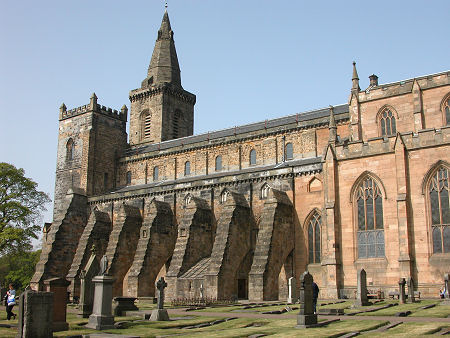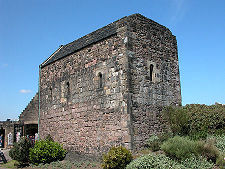 Dunfermline Abbey Church |
Malcolm III Canmore (a.k.a. Máel Coluim mac Donnchada) lived from 1031 to 13 November 1093 and was King of Scotland from 17 March 1058 to 13 November 1093. "Canmore" was an anglicised form of Ceann Mór which has been variously translated as "big head" or, more flatteringly, "great head" or "chief". Malcolm was the first King of the House of Dunkeld, or House of Canmore, that was to rule Scotland for the next 232 years. The wider picture in Scotland at the time is set out in our Historical Timeline.
Malcolm was the son of Duncan I. At the time of the his father's death at the hands of his uncles Macbeth and Thorfinn Sigurdsson, Malcolm was just nine. He sought refuge with his kinsman on his mother's side, Earl Siward Biornsson of Northumbria.
In 1053 Malcolm received military support from King Edward the Confessor of England and invaded southern Scotland, where he received considerable support from nobles in Lothian. On 15 August 1057 Malcolm met Macbeth at the Battle of Lumphanan, in Aberdeenshire, and Macbeth was killed. Macbeth was succeeded by his step son Lulach, a great grandson of Kenneth III. On 17 March 1058 Malcolm caught up with and killed Lulach, becoming Malcolm III in the process. His coronation took place on the Stone of Scone at Scone on 25 April 1058.
Malcolm's first wife was Ingibjörg, the daughter of Thorfinn Sigurdsson, the Earl of Orkney, and they had three sons before her death: Donnchad (Duncan); Domnall (Donald); and Máel Coluim (Malcolm).
In 1070 Malcolm, by now a widower, married Margaret, the great-niece of Edward the Confessor. She had fled to Scotland with her brother Edgar the Atheling, the Anglo-Saxon heir to the English throne, after William I excluded him from the English succession.
Margaret's impact was dramatic. She favoured the Roman Catholic church to the Celtic Church and brought Benedictine monks to establish an abbey at Dunfermline. To allow her to feel more at home, Malcolm decreed that the language used at court should be Anglo-Saxon rather than Gaelic. As a result Malcolm III was the first to be called "King of Scotland" in his own time. Margaret also had built what is today called St Margaret's Chapel, in the highest part of Edinburgh Castle.
Malcolm and Margaret had eight children: Edward; Edmund; Ethelred; Edgar; Alexander; David; Edith or Matilda; and Mary. The extend of Margaret's influence on the future direction of the Scottish crown and of Scotland more widely can be seen by comparing the Gaelic names of the three children from Malcolm's first marriage and the absence of any Gaelic names among the eight from his second.
Malcolm was keen to take advantage of the disruption caused by the Norman conquest of England to further Scotland's interests. More charitably, he was also interested in rolling back the Norman invasion of England to place the "rightful" Anglo-Saxon heir, his brother in law Edgar the Atheling, on the English throne.
Malcolm's repeated invasions of northern England were driven back by William I, and in 1072 Malcolm was forced by William to sign the Treaty of Abernethy. This was a highly significant document, providing a basis for later claims of dominance of the English throne over the Scottish throne. At the same time Malcolm had to give up his eldest son Duncan as a hostage against his future good conduct.
When William I was succeeded by William II in 1087 (and Duncan was released as a hostage), Malcolm decided to invade England once more, this time with fatal results. He was killed at the First Battle of Alnwick on 13 November 1093, aged 62. His eldest son from his second marriage, Prince Edward of Scotland, died alongside him. Margaret was told of the deaths by her second son, Edmund. She died on 16 November 1093 and was was canonised in 1249.
On his death, Malcolm was succeeded by the joint rule of his brother, Donald III, and his second son by Margaret, Edmund. Malcolm was initially buried at Tynemouth Priory, but in 1115 he was exhumed and reburied in Dunfermline Abbey, next to Margaret.




